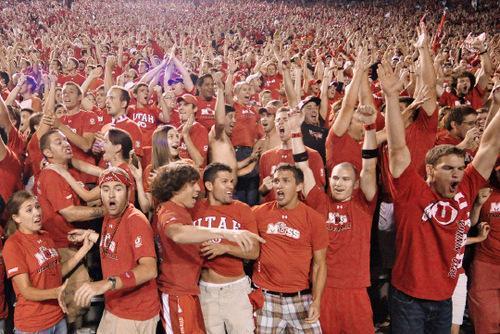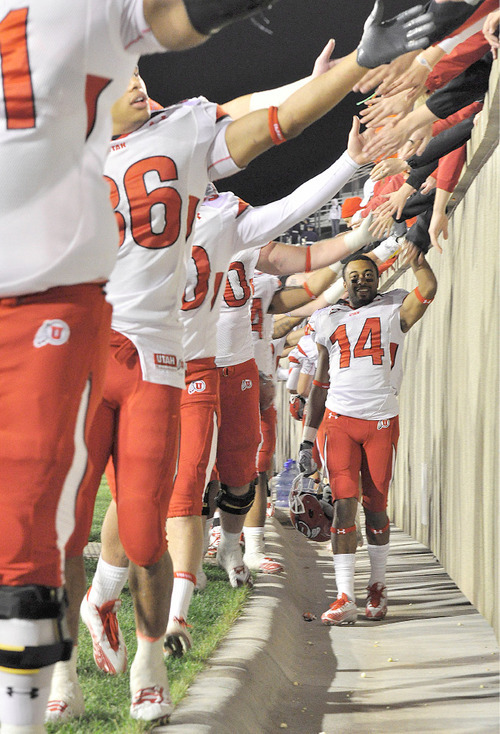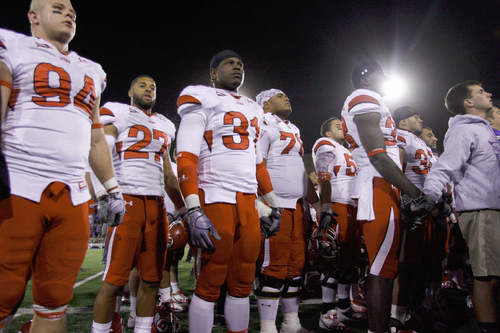This is an archived article that was published on sltrib.com in 2010, and information in the article may be outdated. It is provided only for personal research purposes and may not be reprinted.
Think about Notre Dame football and all sorts of images come to mind.
Touchdown Jesus. The Gipper. The Four Horsemen. The Fighting Irish. Rudy. Knute Rockne. The Golden Dome. The 11 national championships and seven Heisman Trophy winners.
That's the tradition more than 5,000 University of Utah fans will encounter when they make the trip to South Bend, Ind., to watch their Utes play Notre Dame on Saturday, Nov. 13, for the first time.
"If the weather is decent, you will find a vibrant atmosphere on campus beginning Friday afternoon and then continuing Saturday and up until game time and then during and after the game," said Notre Dame spokesman Dennis Brown. "It's a classic college football atmosphere. We get lots of alumni and lots of families. At the same time, we like to think it's a hospitable atmosphere for visiting fans."
Utah fans arriving Friday at South Bend might want to take advantage of a chance to walk through the famous tunnel at Notre Dame and stand on the field where so much college football history has taken place. Brown said Notre Dame officials open the gates and the tunnel to the field on Friday afternoons, offering fans a chance to have their picture taken.
Other Notre Dame football weekend traditions include the band's trumpet section playing inside the Administration Building under the golden dome on Friday afternoon, a pep rally at the Joyce Center on Friday and a midnight drummers circle on the steps of the Main Building. On Saturday, the band plays on the steps of Bond Hall 90 minutes before game time. Mass is held 30 minutes after the game in the Basilica and the Stepan Center on campus.
While the many Ute fans traveling to the game and the thousands more who will watch it on national television Saturday may know a bit about Notre Dame football, the school and its history, they might be surprised at how much they don't know.
So, here is a primer on Notre Dame in general and its football traditions in particular:
About the school • The school was founded Nov. 26, 1842, by 28-year-old French priest Edward Sorin and seven companions, all of them members of the Congregation of Holy Cross. The original 524 acres was donated by the Bishop of Vincenes in the Indiana mission fields. Sorin, using his native French tongue, named the school "L'Université de Notre Dame du Lac" or, in English, "The University of Our Lady of the Lake."
The university does not have as large of a student body as many might think. There are 8,400 undergraduate students and, adding graduate students, a total of 11,800. Eighty-five percent of the students are Catholic and there are five applicants for every freshman accepted. Notre Dame is ranked among the top accounting, theology, history, psychology, pre-med, business and law schools in the country. Given the number of famous television journalists who have graduated from Notre Dame (see famous alumni below), Notre Dame ironically has no journalism department.
Famous Notre Dame alumni • Former Arizona governor and Secretary of the Interior Bruce Babbitt, sportscaster Don Criqui, talk show host Phil Donahue, ESPN radio personality Mike Golic, U.S. Congressman Peter King, author Barry Lopez, former pro football player and current Minnesota Supreme Court Judge Alan Page, Chicago Bulls general manager John Paxson, television personality Regis Philbin, former Secretary of State Condoleezza Rice, and ESPN reporter Hannah Storm.
About the football team • Notre Dame began playing football in 1887. Since that time, it has experienced 102 winning seasons, 13 seasons with a losing record and five .500 records. The Fighting Irish have had 12 unbeaten, untied seasons, 10 more unbeaten years with one tie and 28 one-loss seasons. The school has produced seven Heisman Trophy winners. Since the Associated Press football poll started in 1936, Notre Dame has played 278 games against teams ranked in the top 25 going into the season and has a 142-126-10 record in those games.
About the stadium • The current Notre Dame Stadium seats 80,795 after a $50 million expansion project adding more than 21,000 seats was completed before the 1997 kickoff. Every game since 1966 has been a sellout except for one, a 1973 Thanksgiving Day game against Air Force. Notre Dame Stadium was built in 1930 during the Knute Rockne era. It was engineered by Osborn Engineering Company, which designed more than 50 stadiums including such famed edifices as Comiskey Park in Chicago, Yankee Stadium and the Polo Grounds in New York City, and the Minnesota, Michigan, Indiana and Purdue fields. Its original cost was just over $750,000 and it most closely resembles Michigan's huge Big House. According to Notre Dame athletics, the original contained more than two million bricks, 400 tons of steel and 15,000 cubic yards of concrete. It measures a half-mile in circumference. Entering the 2009 season, the Irish hosted 62 different opponents — Utah has never played there until now though BYU has — and compiled a record of 302-98-5.
How Notre Dame became "The Fighting Irish" • Notre Dame was known as the Catholics in the 1800s and then as the Ramblers in the 1920s because they rambled all over the nation for games. One story said the Irish nickname was first heard in an 1899 game against Northwestern when the Wildcat fans began chanting "Kill the Fighting Irish!" Another legend has it that during the Notre Dame-Michigan game in 1909, a teammate yelled at players who happened to be Irish that "You're all Irish and you're not fighting worth a lick." According to spokesman Dennis Brown, the term "Fighting Irish" was a taunt born of an anti-immigration, anti-Catholic feeling against all ethnic Catholics in the early 1900s. "We took a slur and turned it into an in-your-face expression of triumph," said Brown.
The school adopted the "Fighting Irish" officially as its nickname in 1927. Notre Dame graduate Francis Wallace, a writer in the 1920s for the New York Daily News, is credited with making it popular.
The leprechaun mascot was not officially adopted until 1965. Before then, the school was represented by Irish terriers.
What is "Touchdown Jesus?" • According to Brown, this is a mosaic conceived by artist Millard Sheets and officially called "The Word of Life." It is constructed out of thousands of pieces of rock and stone. It was hung on the wall of the Notre Dame library in the 1960s using a complex engineering scheme with a cushion of air to keep it from freezing and thawing.
"It does overlook Notre Dame stadium and from various points of the stadium, you can look at the north and it looks like Jesus signaling a touchdown," said Brown. "But that is wholly coincidental. No one ever thought about having Jesus signaling. It is a symbolic piece of art. Jesus is represented a teacher of saints and scholars through the ages. If you see all of it, you can view the saints and scholars at the feet of Jesus the teacher."
What is the "The Golden Dome?" • The Golden Dome is Notre Dame's Main Administration Building. It was built in 1879 after a fire destroyed another building. The dome was added in 1882 and reguilded in 2005. It is topped by a 190-foot-tall, 4,000-pound statue of the Virgin Mary.
Why is Knute Rockne a famous Notre Dame coach? • Rockne was a Norwegian immigrant who grew up in Chicago. He played Notre Dame football, graduating in 1913. He came back to the school as a graduate assistant in chemistry and helped as a football assistant, taking over for coach Jesse Harper after the 1917 season. He coached for 13 years and put Notre Dame on the map nationally as a football power by compiling a record of 105-12-5; he produced 20 all-Americans and was the first coach to take his team all over the country. He was also known as an inventor of football equipment, making it lighter while increasing its protectiveness. He died in a plane crash in 1931.
Who was "the Gipper?"• The Gipper refers to George Gipp, an athlete who never played high school football but was recruited to play for Notre Dame by coach Rockne in 1916. Gipp was known as a great all-around player: a runner, a passer and punter. He ran for 2,341 yards, a mark that lasted more than 50 years.
He died from strep throat on Dec. 14, 1920, just two weeks after his last game. On his deathbed, he told Rockne: "I've got to go, Rock. It's all right. I'm not afraid. Some time, Rock, when the team is up against it, when things are wrong and the breaks are beating the boys — tell them to go in there with all they've got and win just one for the Gipper. I don't know where I'll be then, Rock. But I'll know about it, and I'll be happy."
The coach let eight years pass before using Gipp's parting request, waiting until the Irish were huge underdogs to Army in a game played on Nov. 10, 1928, in Yankee Stadium. At halftime, Rockne gathered his team and said: "The day before he died, George Gipp asked me to wait until the situation seemed hopeless — then ask Notre Dame to go out and beat Army for him. This is the day, and you are the team."
The team won 12-6 on a pair of second-half touchdowns. When Jack Chevigny scored the first on a one-yard run, he said: "That's one for the Gipper."
Who were "The Four Horsemen?" • Sports writer Grantland Rice immortalized Notre Dame quarterback Harry Stuhldreher, halfbacks Jim Crowley and Don Miller and fullback Elmer Layden with these words in the New York Herald-Tribune after Notre Dame's 13-7 victory over Army on Oct. 18, 1924:
"Outlined against a blue, gray October sky the Four Horsemen rode again. In dramatic lore they are known as famine, pestilence, destruction and death. These are only aliases. Their real names are: Stuhldreher, Miller, Crowley and Layden. They formed the crest of the South Bend cyclone before which another fighting Army team was swept over the precipice at the Polo Grounds this afternoon as 55,000 spectators peered down upon the bewildering panorama spread out upon the green plain below."
When the team arrived back in South Bend, Rockne's student publicity aide George Srickler posed the four players dressed in their uniforms on the back of four horses, a famous photo picked up by wire services around the world. The team went on to go 10-0 that season and win the national championship.
Who was Rudy? • Daniel E. "Rudy" Ruetiger became famous after the 1993 movie "Rudy" about a walk-on who dreamed of playing for Notre Dame. He graduated from Notre Dame in 1976 and actually participated in two plays against Georgia Tech, sacking the quarterback on the last one.







